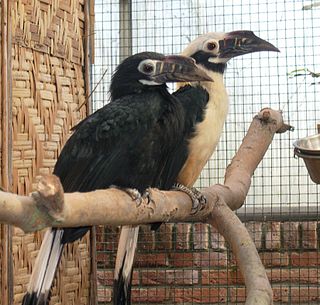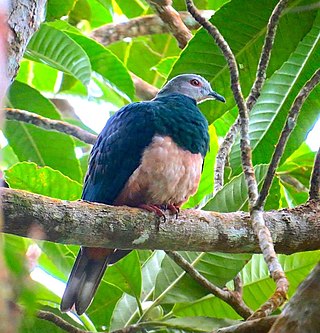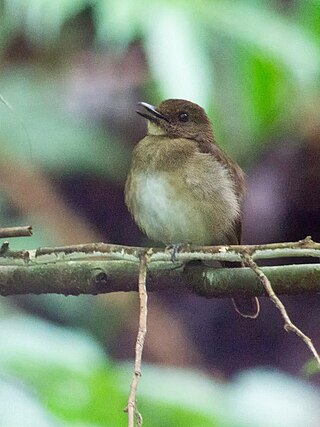
The Visayan hornbill is a hornbill found in rainforests of Western Visayas region which includes the islands of Panay, Negros,Cebu and Guimaras, as well as the island of Masbate, and formerly Ticao, in the Philippines. It formerly included all other Philippine tarictic hornbills as subspecies, in which case the common name of the 'combined species' was shortened to tarictic hornbill.

Walden's hornbill locally called dulungan, also known as the Visayan wrinkled hornbill, rufous-headed hornbill or writhe-billed hornbill, is a critically endangered species of hornbill living in the rainforests on the islands of Negros and Panay in the Philippines. It is closely related to the writhed hornbill, but can be recognized by the yellow throat and ocular skin in the male, and the blue throat and ocular skin in the female. Its binomial name commemorates the Scottish ornithologist Viscount Walden.

The Mindoro bleeding-heart, also referred to as kulo-kulo, la-do, manatad, manuk-manuk, punay, and puñalada by the Mangyan, is a species of ground dove native solely to the island of Mindoro in the Philippines. It is critically endangered and threatened by habitat loss largely motivated by marble extraction. Due to its biological line and its survival status, it has been listed as an EDGE species by the Zoological Society of London.

The pink-bellied imperial pigeon, also known as the zone-tailed pigeon, is found in the Philippines. It is a large fruit-eating bird reaching sizes of up to 42cm long.

The Sulu bleeding-heart or Tawitawi bleeding-heart is a species of bird in the pigeon and dove family, Columbidae. It is endemic to the island of Tawi-Tawi and its surrounding islets in the Philippines' Sulu Archipelago. This species is known only from two specimens collected in 1891, and has not been recorded with certainty since. It lives in primary and secondary forests that have a closed canopy. The Sulu bleeding-heart is a medium-sized pigeon with a short tail. Bright metallic green feathers stretch from the forehead and crown down to the mantle and sides of the breast, where they surround a large, pale orange breast spot with diffuse edges that gives the species the name "bleeding-heart". The lower wings and back are varying shades of brown, and the throat and chest are largely white. The belly is an ashy-gray.

The Palawan hornbill is a large forest bird endemic to the Philippines. It is one of the 11 endemic hornbills in the country. It is only found in Palawan and nearby islands of Balabac, Busuanga, Calauit, Culion and Coron. It is locally known as 'talusi' in the language Cuyunon, It is threatened by habitat loss, hunting and trapping for the cage-bird trade.

The Mindoro hornbill is a species of hornbill in the family Bucerotidae. It is endemic to forests on Mindoro in the Philippines found in tropical moist lowland forests. As is the case with all Philippine tarictic hornbills, it was once considered a subspecies of P. panini. It is the only tarictic hornbill where both sexes are creamy-white and black. The sexes are very similar, differing primarily in the colour of the ocular ring. It is threatened by habitat loss, and is consequently considered endangered by the IUCN.

The Mindanao bleeding-heart, also known as Bartlett's bleeding heart dove, Barlett's bleeding heart pigeon and the hair-breasted bleeding heart, is a species of bird in the pigeon family. It is endemic to the Philippines on the islands of Mindanao, Basilan, Samar, Leyte and Bohol. It is so named because of a red blotch on its breast. The generic name derives from a fusion of the Latin gallus ("chicken") and columba ("pigeon").
The Wetar ground dove is a species of bird in the family Columbidae found on Wetar, Indonesia, and on Timor. Its natural habitats are monsoon forests and gallery forests, and possibly woodland and bamboos. Threatened by habitat loss and hunting, the species is assessed as endangered by the IUCN.

The Negros fruit dove is a species of bird in the pigeon and dove family, Columbidae. It is endemic to the island of Negros in the Philippines. This fruit dove is known from a single female specimen collected from the slopes of Mount Kanlaon in the northern part of the island. While it was found at a high elevation, it is suspected that the species originally lived in the lowland dipterocarp forests and was driven to higher elevations by habitat destruction. While some have suggested that the specimen is either a runt or a hybrid instead of a valid species, this is not widely accepted. The female Negros fruit dove was a small fruit dove with vivid dark green plumage and an ashy-grey forehead. It had a distinctive ring of bare yellow skin around its eye, and yellow fringes to some of its feathers gave it the appearance of having a yellow wingbar when perched. The throat was white, while the undertail and vent were yellow.

The flame-breasted fruit dove is a species of bird in the family Columbidae. It is endemic to the Philippines only being found in the mountains of Luzon.This is a large dove reaching 42 cm long, being the largest fruit dove in the country and rivalling the size of Imperial pigeons. It is identified with its red hood, black wings with a red patch on its secondaries and its unmistakable flame-coloured breast. Its natural habitats are in upper areas of the tropical moist lowland forest and in mid to upper montane forest. It is threatened by habitat loss, poaching for the pet trade and hunting for food.

The white-winged cuckooshrike, also known as white-winged cicadabird or white-winged graybird, is a species of bird in the family Campephagidae. It is endemic to the Philippines found on the islands of Negros, Panay and formerly on Guimaras. Some taxonomists place this species in the genus Analisoma.
The flame-templed babbler is a species of bird of the family Zosteropidae, in the genus Dasycrotapha. It is one of the most remarkable and distinctive birds with its complex head markings with orange crown tufts, black ears and yellow beak and face. It is endemic to the Philippines, where it is found on the islands of Panay and Negros. Its natural habitat is tropical moist lowland forest. It is threatened by habitat loss. Along with the Negros striped babbler, it is one of the two babbler species extremely sought after by birdwatchers on Negros.

The black-belted flowerpecker or Visayan flowerpecker, is a species of bird in the family Dicaeidae. It is endemic to the Philippines where it is restricted to Panay, Negros and Guimaras islands. It was formerly regarded as a subspecies of the more widespread red-keeled flowerpecker. Sometimes the name red-keeled flowerpecker is used for D. haematostictum and D. australe is then known as the red-sided flowerpecker.

The white-throated jungle flycatcher, also known as the Negros jungle flycatcher is a species of bird in the Old World flycatcher family Muscicapidae. It is endemic to the Philippines and formerly on Guimaras before its extirpation there. The natural habitats of the white-throated jungle flycatcher are tropical moist lowland forests and tropical moist montane forests at altitudes of up to 1,350 meters. It is threatened by habitat loss.
The Negros striped babbler is a species of bird in the family Zosteropidae. It is endemic to Negros Island (Philippines).

The Negros scops owl, also known as the Visayan scops owl, is an owl, endemic to the islands of Negros and Panay in the Philippines, belonging to the family of the typical owls Strigidae. It was formerly classified as a subspecies of the Philippine scops owl. It is threatened by habitat loss and hunting for the pet trade.
The Visayan rhabdornis is a species of bird currently placed in the starling family, Sturnidae. It is endemic to the central Philippines on the islands of Negros and Panay. It was previously considered a subspecies of the stripe-breasted rhabdornis. It lives in tropical moist montane forest and is threatened by habitat loss.















